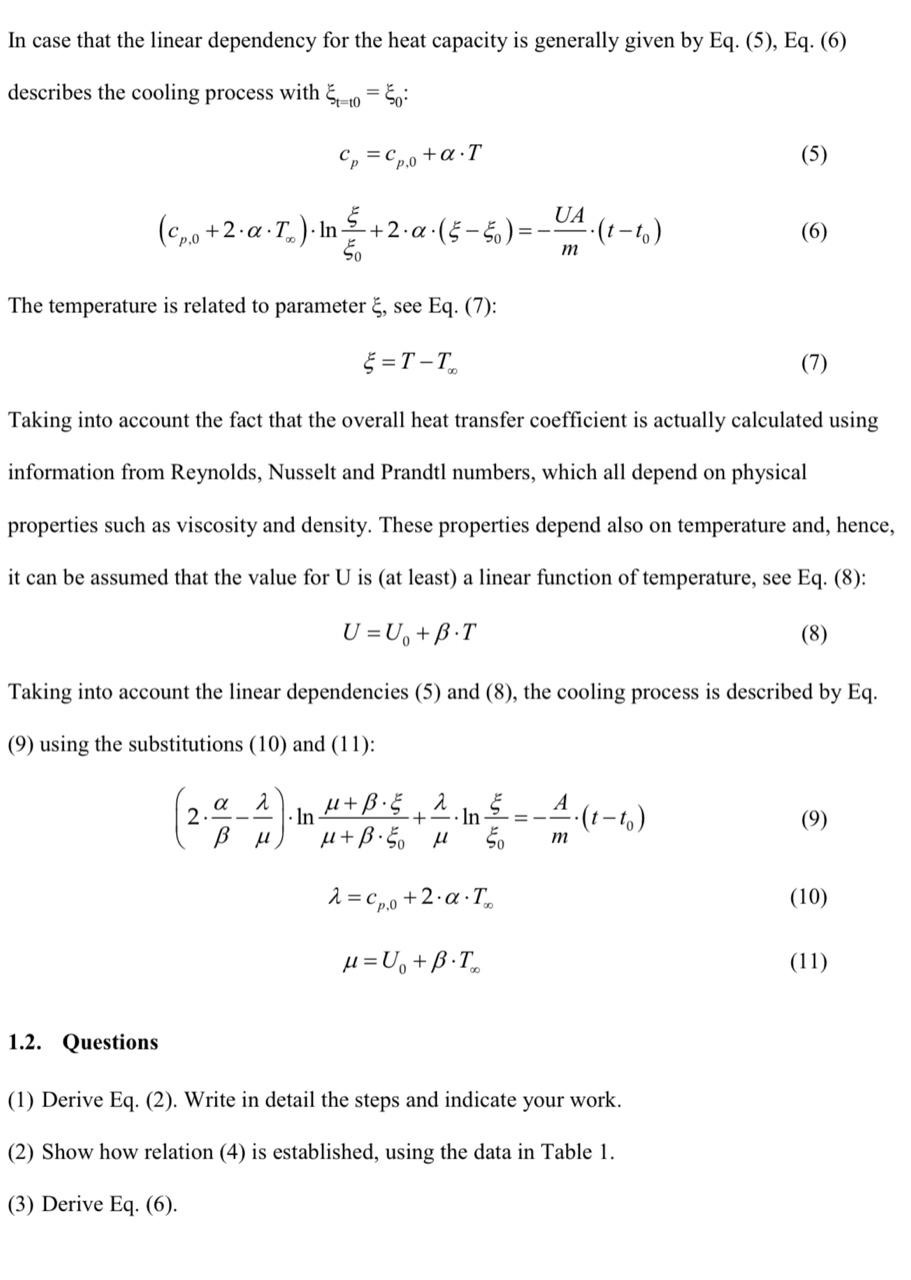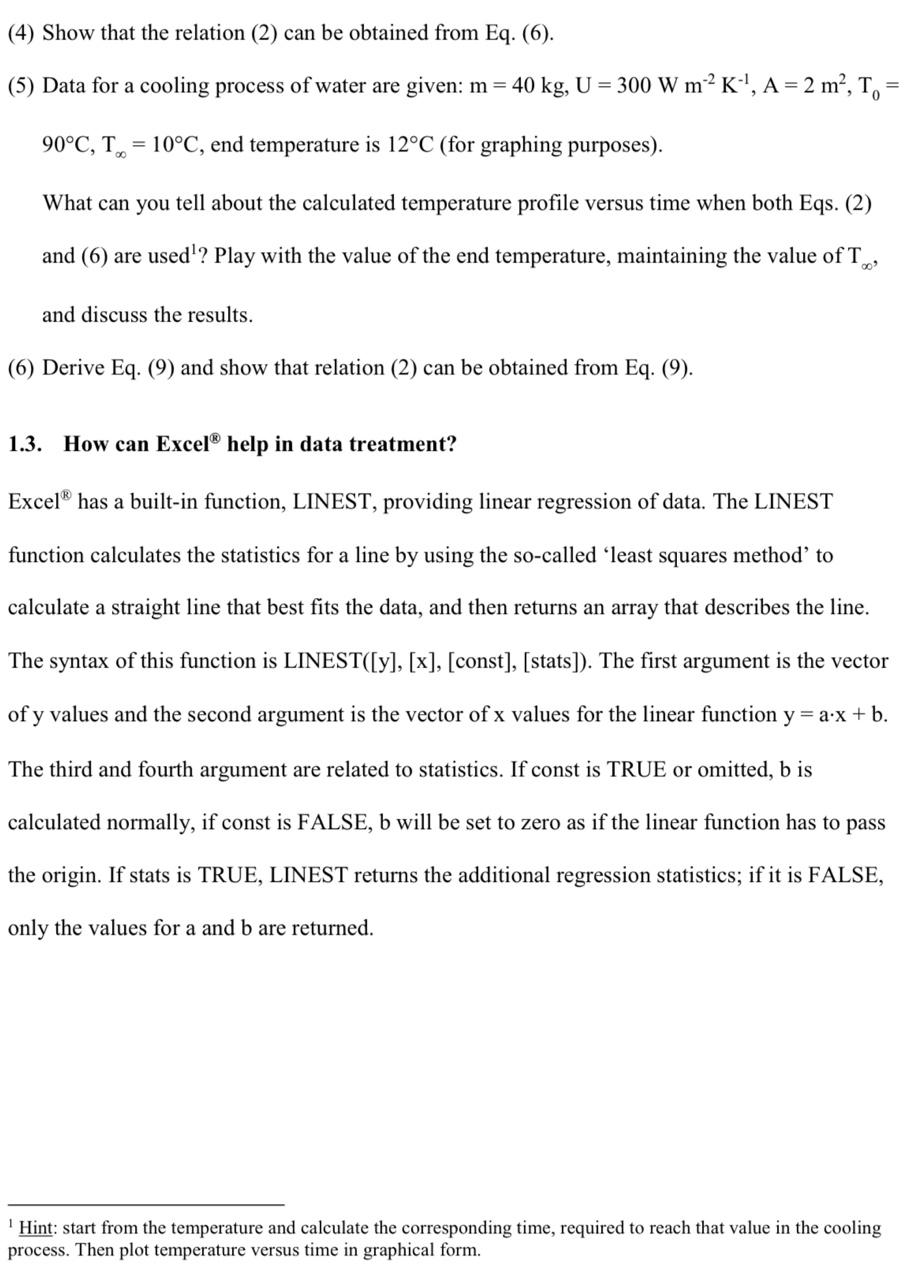Answered step by step
Verified Expert Solution
Question
1 Approved Answer
A mass m (kg) at temperature T is cooling down until temperature T is theoretically reached. 00 The material has a specific heat capacity




A mass m (kg) at temperature T is cooling down until temperature T is theoretically reached. 00 The material has a specific heat capacity cp, (J kg- K-). The variation in temperature can be described by Eq. (1) with U and A the overall heat transfer coefficient (W m2 K-) and the area for heat transfer (m): d (mc,T) = -UA-(T-T) dt If the specific heat capacity does not depend on the temperature, Eq. (1) is readily integrated with the initial condition To To: T-T T-T In = exp Cp T-T To-To 8- UA mc. Eq. (2) can be considered to be a general cooling law and it can explain the cooling behavior of metal blocks, a cup of coffee and many other objects. The logarithmic form is given by Eq. (3) for a general time to: UA mc, P P 1) (1) --(t-to) (2) = 4.256-4.781.10-.T In case that water cools down, it can be verified that the specific heat capacity does depend on the temperature T (in C), see Table 1. If a linear dependency is proposed, Eq. (4) can be used for these data with c, in kJ kg- K-: (3) (4) 1 In case that the linear dependency for the heat capacity is generally given by Eq. (5), Eq. (6) describes the cooling process with too (C+2aT.). In +2a-(5-5) = -UA (1. -.(t-to) m 2 C,=C,0+a T P.0 a 2 The temperature is related to parameter , see Eq. (7): = T-To Taking into account the fact that the overall heat transfer coefficient is actually calculated using information from Reynolds, Nusselt and Prandtl numbers, which all depend on physical properties such as viscosity and density. These properties depend also on temperature and, hence, it can be assumed that the value for U is (at least) a linear function of temperature, see Eq. (8): U=U+B.T (8) Taking into account the linear dependencies (5) and (8), the cooling process is described by Eq. (9) using the substitutions (10) and (11): In +B.E 2. + In +B.5 50 =C P.0 +2.a. T =U+B.T A m --(t-to) (5) 1.2. Questions (1) Derive Eq. (2). Write in detail the steps and indicate your work. (2) Show how relation (4) is established, using the data in Table 1. (3) Derive Eq. (6). (6) (7) (10) (11) (4) Show that the relation (2) can be obtained from Eq. (6). (5) Data for a cooling process of water are given: m = 40 kg, U = 300 W m K, A = 2 m, T = 90C, To = 10C, end temperature is 12C (for graphing purposes). What can you tell about the calculated temperature profile versus time when both Eqs. (2) and (6) are used? Play with the value of the end temperature, maintaining the value of T and discuss the results. (6) Derive Eq. (9) and show that relation (2) can be obtained from Eq. (9). 1.3. How can Excel help in data treatment? Excel has a built-in function, LINEST, providing linear regression of data. The LINEST function calculates the statistics for a line by using the so-called 'least squares method' to calculate a straight line that best fits the data, and then returns an array that describes the line. The syntax of this function is LINEST([y], [x], [const], [stats]). The first argument is the vector of y values and the second argument is the vector of x values for the linear function y = ax + b. The third and fourth argument are related to statistics. If const is TRUE or omitted, b is calculated normally, if const is FALSE, b will be set to zero as if the linear function has to pass the origin. If stats is TRUE, LINEST returns the additional regression statistics; if it is FALSE, only the values for a and b are returned. Hint: start from the temperature and calculate the corresponding time, required to reach that value in the cooling process. Then plot temperature versus time in graphical form. Table 1: Heat capacity versus temperature for water at 1 atm. T (C) Cp (kJ kg- K-) 10 20 25 30 40 50 60 70 80 90 100 4.191 4.157 4.138 4.118 4.074 4.027 3.977 3.925 3.873 3.821 3.768
Step by Step Solution
★★★★★
3.52 Rating (159 Votes )
There are 3 Steps involved in it
Step: 1
Here is the graph depicting the cooling of a mass ...
Get Instant Access to Expert-Tailored Solutions
See step-by-step solutions with expert insights and AI powered tools for academic success
Step: 2

Step: 3

Ace Your Homework with AI
Get the answers you need in no time with our AI-driven, step-by-step assistance
Get Started


